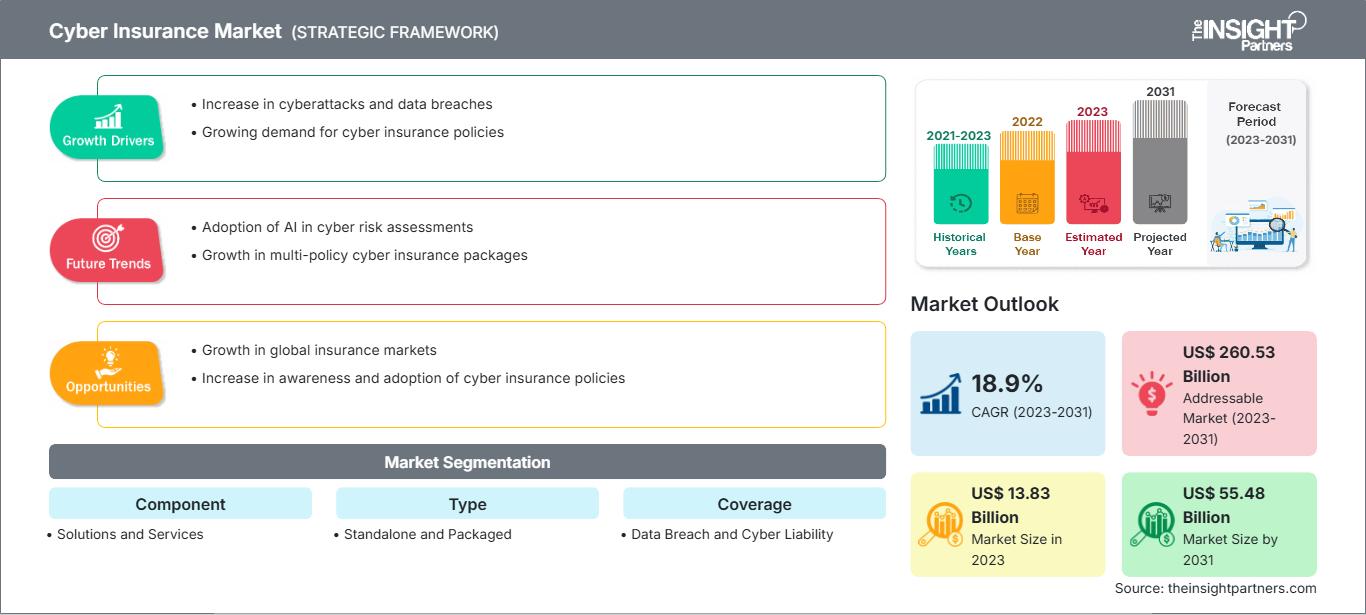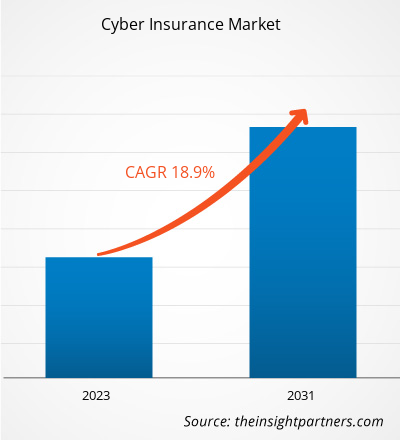Se prevé que el mercado de seguros cibernéticos crezca de 13.830 millones de dólares en 2023 a 55.480 millones de dólares en 2031, con una tasa de crecimiento anual compuesta (TCAC) del 18,9 % entre 2023 y 2031. El seguro cibernético, también conocido como seguro de responsabilidad cibernética o seguro de ciberseguridad, es un contrato que una organización puede adquirir para mitigar los riesgos financieros asociados a la actividad comercial en línea. A cambio de una cuota mensual o trimestral, la póliza transfiere parte del riesgo a la aseguradora.
Análisis del mercado de seguros cibernéticos
El pronóstico del mercado de seguros cibernéticos se estima a partir de diversos hallazgos de investigación primaria y secundaria, como publicaciones de empresas clave, datos de asociaciones y bases de datos. Los seguros cibernéticos son cada vez más importantes para todas las empresas, dado que la amenaza de ciberataques contra aplicaciones, dispositivos, redes y usuarios va en aumento. Esto se debe a que la filtración, la pérdida o el robo de datos pueden tener un impacto sustancial en un negocio, desde la pérdida de clientes hasta daños económicos y reputacionales. Las empresas también pueden ser consideradas responsables por los daños causados por la pérdida o el robo de datos de terceros. Una póliza de seguro cibernético puede proteger a la organización de eventos cibernéticos, como el ciberterrorismo, y ayudar a resolver incidentes de seguridad. Por ejemplo, según un informe de 2024 de ASTRA IT, Inc., las estadísticas de ciberseguridad muestran que se producen 2200 ciberataques diarios, con un promedio de uno cada 39 segundos. En Estados Unidos, una filtración de datos cuesta un promedio de 9,44 millones de dólares, y se estima que los costos de la ciberdelincuencia alcanzarán los 8 billones de dólares en 2023.
Seguros cibernéticos
Panorama general del sector
- Los ciberataques y el número de activos digitales comprometidos aumentaron simultáneamente. El ransomware y los ataques a la cadena de suministro han dominado el panorama del riesgo cibernético en los últimos años. Los futuros ciberataques se verán acelerados por importantes tendencias tecnológicas como la inteligencia artificial (IA), como ChatGPT, el llamado "metaverso" y la expansión de los sectores de TI, IoT y tecnología operativa (TO).
- Los incidentes de malware aumentaron en 2022, alcanzando los 5.500 millones de ataques, un incremento del 2% interanual, según el Informe de Amenazas Cibernéticas de SonicWall para 2023. El malware es un software malicioso que infecta un ordenador y tiene como objetivo interrumpir, dañar u obtener acceso no autorizado al sistema informático.
- Además de la creciente sofisticación de las operaciones de los ciberdelincuentes, las empresas de todo el mundo son más vulnerables que nunca a las crisis geopolíticas, que ya están teniendo una influencia sin precedentes en la ciberseguridad. En la era digital actual, la gestión del riesgo cibernético es esencial. La demanda de seguros cibernéticos es alta debido a su importancia fundamental. Crear un mercado de seguros cibernéticos sólido es una tarea crucial para el sector asegurador.
Obtendrá personalización gratuita de cualquier informe, incluyendo partes de este informe, análisis a nivel de país y paquetes de datos de Excel. Además, podrá aprovechar excelentes ofertas y descuentos para empresas emergentes y universidades.
Mercado de seguros cibernéticos: Perspectivas estratégicas

-
Obtenga las principales tendencias clave del mercado que se describen en este informe.Esta muestra GRATUITA incluirá análisis de datos, desde tendencias del mercado hasta estimaciones y pronósticos.
Impulsor del mercado de seguros cibernéticos
El aumento de la concienciación sobre los riesgos cibernéticos impulsará el mercado de los seguros cibernéticos.
- El aumento de los ciberataques, junto con un mayor conocimiento de este tipo de delitos, ha generado una mayor demanda de seguros cibernéticos. Este incremento también ha provocado un aumento de las reclamaciones para las aseguradoras, obligándolas a endurecer sus criterios de suscripción.
- En Estados Unidos, desde 2004, octubre se celebra como el Mes de la Concienciación sobre la Ciberseguridad. Cada año, durante este mes, los sectores público y privado colaboran para sensibilizar sobre la importancia de la ciberseguridad. Con el tiempo, se ha convertido en un esfuerzo conjunto entre el gobierno y la industria para fomentar la concienciación sobre la ciberseguridad, inspirar acciones ciudadanas para reducir los riesgos en línea y generar debate a nivel nacional e internacional sobre los peligros cibernéticos. Octubre de 2023 fue el vigésimo Mes de la Concienciación sobre la Ciberseguridad.
- En 2023, la Agencia de Ciberseguridad e Infraestructura (CISA) de EE. UU. lanzó un programa de concientización sobre ciberseguridad llamado «Protejamos nuestro mundo». Este será el tema central de todos los meses de concientización sobre ciberseguridad venideros.
- De igual forma, muchos países del mundo han puesto en marcha programas para concienciar a la ciudadanía sobre la ciberseguridad. Por ejemplo, la Estrategia de Ciberseguridad de Polonia para el período 2019-2024 tiene como objetivo mejorar la resistencia a las ciberamenazas y reforzar la protección de datos, lo que incluye aumentar la concienciación sobre la ciberseguridad. La Estrategia de Ciberseguridad de Portugal para el período 2019-2023 se centra en la prevención, la educación y la concienciación, e incluye medidas específicas como la promoción de programas de formación transversales en ciberseguridad para organizaciones y ciudadanos, el fortalecimiento de las competencias en seguridad cibernética en la educación y el fomento de la alfabetización digital.
Seguros cibernéticos
Análisis de segmentación del informe de mercado
- Según el usuario final, el informe del mercado de seguros cibernéticos se segmenta en atención médica, comercio minorista, servicios financieros, TI y telecomunicaciones, manufactura y otros.
- Se prevé que el sector de banca, servicios financieros y seguros (BFSI) mantenga una importante cuota de mercado en el ámbito de los ciberseguros en 2023. Ante el creciente riesgo cibernético, los bancos y las instituciones financieras están priorizando el fortalecimiento de su resiliencia cibernética. Las instituciones financieras abarcan un amplio espectro operativo en numerosas líneas de negocio y requieren un plan integral de ciberseguros para gestionar los ciberataques y las interrupciones de la actividad.
Seguros cibernéticos
Análisis de mercado por geografía
El alcance del informe sobre el mercado de seguros cibernéticos se divide principalmente en cinco regiones: Norteamérica, Europa, Asia Pacífico, Oriente Medio y África, y Sudamérica. Norteamérica está experimentando un rápido crecimiento y se prevé que mantenga una cuota de mercado significativa en el sector. Este liderazgo se debe a la infraestructura tecnológica superior de la región, la presencia de grandes multinacionales y una mayor concienciación sobre los riesgos cibernéticos.
Seguros cibernéticos
Perspectivas regionales del mercado de seguros cibernéticos
Los analistas de The Insight Partners han explicado en detalle las tendencias y los factores regionales que influyen en el mercado de seguros cibernéticos durante el período de previsión. Esta sección también analiza los segmentos y la geografía del mercado de seguros cibernéticos en Norteamérica, Europa, Asia Pacífico, Oriente Medio y África, y Sudamérica y Centroamérica.
Alcance del informe sobre el mercado de seguros cibernéticos
| Atributo del informe | Detalles |
|---|---|
| Tamaño del mercado en 2023 | 13.830 millones de dólares estadounidenses |
| Tamaño del mercado en 2031 | 55.480 millones de dólares estadounidenses |
| CAGR global (2023-2031) | 18,9% |
| Datos históricos | 2021-2023 |
| Período de pronóstico | 2023-2031 |
| Segmentos cubiertos |
Por componente
|
| Regiones y países cubiertos |
América del norte
|
| Líderes del mercado y perfiles de empresas clave |
|
Densidad de los participantes en el mercado de seguros cibernéticos: comprensión de su impacto en la dinámica empresarial
El mercado de seguros cibernéticos está creciendo rápidamente, impulsado por la creciente demanda de los usuarios finales debido a factores como la evolución de las preferencias de los consumidores, los avances tecnológicos y una mayor conciencia de los beneficios del producto. A medida que aumenta la demanda, las empresas amplían su oferta, innovan para satisfacer las necesidades de los consumidores y aprovechan las tendencias emergentes, lo que impulsa aún más el crecimiento del mercado.

- Obtenga una visión general de los principales actores del mercado de seguros cibernéticos.
El análisis del mercado de seguros cibernéticos se realizó considerando las principales estrategias de inversión y la geografía. En cuanto al tipo, el mercado se segmenta en seguros independientes y seguros combinados. Geográficamente, se divide en Norteamérica, Europa, Asia Pacífico, Oriente Medio y África, y Sudamérica.
Seguros cibernéticos
Noticias del mercado y novedades recientes
En el mercado de seguros cibernéticos, las empresas adoptan estrategias tanto inorgánicas como orgánicas, como fusiones y adquisiciones. A continuación, se enumeran algunos de los principales avances recientes del mercado:
- En febrero de 2023, Munich Re Specialty Insurance (MRSI) anunció el lanzamiento de Reflex, un programa personalizado de gestión de riesgos cibernéticos. Reflex es un programa integral gestionado por un equipo de especialistas de Munich Re. Los asegurados contarán con acceso guiado a servicios adaptados a sus necesidades cambiantes. Un equipo de profesionales del sector en privacidad, seguridad de redes y formación y concienciación cibernética se encarga de la prestación de los servicios del programa.
[Fuente: Munich Re, sitio web de la empresa]
Seguros cibernéticos
Cobertura y entregables del informe de mercado
El informe de mercado "Tamaño y pronóstico del mercado de seguros cibernéticos (2021-2031)" proporciona un análisis detallado del mercado que abarca las siguientes áreas:
- Tamaño y pronóstico del mercado a nivel mundial, regional y nacional para todos los segmentos clave del mercado cubiertos por el alcance.
- Dinámica del mercado: factores impulsores, restricciones y oportunidades clave.
- Tendencias clave futuras.
- Análisis detallado de PEST y SWOT
- Análisis de mercado global y regional que abarca las principales tendencias del mercado, los actores clave, las regulaciones y los desarrollos recientes del mercado.
- Análisis del panorama industrial y de la competencia, que incluye la concentración del mercado, el análisis de mapas de calor, los actores clave y los desarrollos recientes.
- Perfiles detallados de las empresas.
- Análisis histórico (2 años), año base, pronóstico (7 años) con CAGR
- Análisis PEST y FODA
- Tamaño del mercado, valor/volumen: global, regional y nacional
- Industria y panorama competitivo
- Conjunto de datos de Excel
Informes recientes
Informes relacionados
Testimonios
Razón para comprar
- Toma de decisiones informada
- Comprensión de la dinámica del mercado
- Análisis competitivo
- Información sobre clientes
- Pronósticos del mercado
- Mitigación de riesgos
- Planificación estratégica
- Justificación de la inversión
- Identificación de mercados emergentes
- Mejora de las estrategias de marketing
- Impulso de la eficiencia operativa
- Alineación con las tendencias regulatorias






















 Obtenga una muestra gratuita para - Mercado de seguros cibernéticos
Obtenga una muestra gratuita para - Mercado de seguros cibernéticos